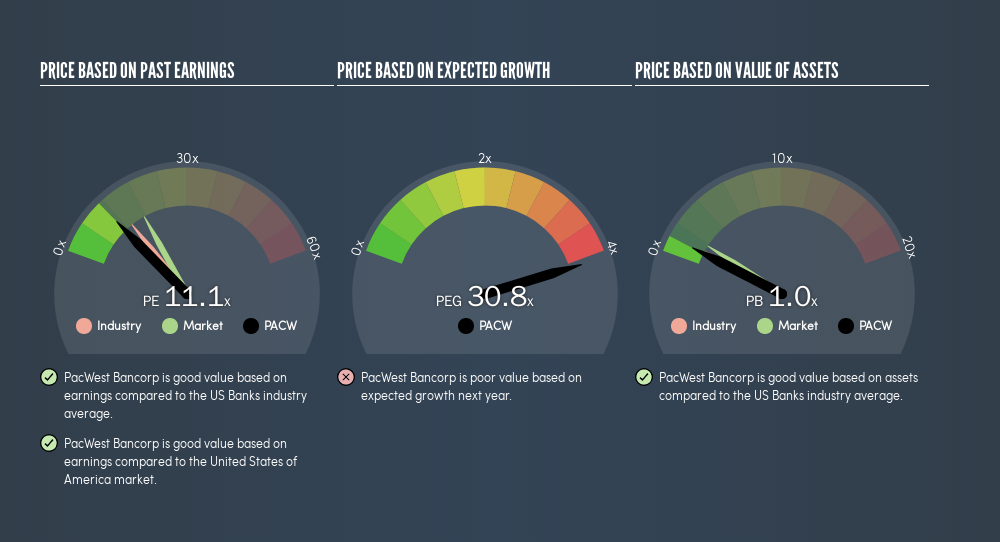
This article is written for those who want to get better at using price to earnings ratios (P/E ratios). To keep it practical, we'll show how PacWest Bancorp's (NASDAQ:PACW) P/E ratio could help you assess the value on offer. PacWest Bancorp has a price to earnings ratio of 11.08, based on the last twelve months. That corresponds to an earnings yield of approximately 9.0%.
Check out our latest analysis for PacWest Bancorp
How Do You Calculate A P/E Ratio?
The formula for price to earnings is:
Price to Earnings Ratio = Price per Share ÷ Earnings per Share (EPS)
Or for PacWest Bancorp:
P/E of 11.08 = $41.26 ÷ $3.72 (Based on the year to December 2018.)
Is A High Price-to-Earnings Ratio Good?
A higher P/E ratio means that investors are paying a higher price for each $1 of company earnings. That isn't a good or a bad thing on its own, but a high P/E means that buyers have a higher opinion of the business's prospects, relative to stocks with a lower P/E.
How Growth Rates Impact P/E Ratios
Probably the most important factor in determining what P/E a company trades on is the earnings growth. When earnings grow, the 'E' increases, over time. That means unless the share price increases, the P/E will reduce in a few years. A lower P/E should indicate the stock is cheap relative to others -- and that may attract buyers.
PacWest Bancorp increased earnings per share by a whopping 28% last year. And its annual EPS growth rate over 5 years is 17%. With that performance, I would expect it to have an above average P/E ratio.
How Does PacWest Bancorp's P/E Ratio Compare To Its Peers?
The P/E ratio indicates whether the market has higher or lower expectations of a company. If you look at the image below, you can see PacWest Bancorp has a lower P/E than the average (13.6) in the banks industry classification.

PacWest Bancorp's P/E tells us that market participants think it will not fare as well as its peers in the same industry. Since the market seems unimpressed with PacWest Bancorp, it's quite possible it could surprise on the upside. It is arguably worth checking if insiders are buying shares, because that might imply they believe the stock is undervalued.
A Limitation: P/E Ratios Ignore Debt and Cash In The Bank
Don't forget that the P/E ratio considers market capitalization. Thus, the metric does not reflect cash or debt held by the company. Hypothetically, a company could reduce its future P/E ratio by spending its cash (or taking on debt) to achieve higher earnings.
Such expenditure might be good or bad, in the long term, but the point here is that the balance sheet is not reflected by this ratio.
PacWest Bancorp's Balance Sheet
PacWest Bancorp's net debt is 29% of its market cap. This is enough debt that you'd have to make some adjustments before using the P/E ratio to compare it to a company with net cash.
The Bottom Line On PacWest Bancorp's P/E Ratio
PacWest Bancorp has a P/E of 11.1. That's below the average in the US market, which is 17.7. The company does have a little debt, and EPS growth was good last year. The low P/E ratio suggests current market expectations are muted, implying these levels of growth will not continue.
Investors have an opportunity when market expectations about a stock are wrong. If the reality for a company is not as bad as the P/E ratio indicates, then the share price should increase as the market realizes this. So this freevisualization of the analyst consensus on future earnings could help you make the right decision about whether to buy, sell, or hold.
Of course, you might find a fantastic investment by looking at a few good candidates. So take a peek at this freelist of companies with modest (or no) debt, trading on a P/E below 20.
We aim to bring you long-term focused research analysis driven by fundamental data. Note that our analysis may not factor in the latest price-sensitive company announcements or qualitative material.
If you spot an error that warrants correction, please contact the editor at editorial-team@simplywallst.com. This article by Simply Wall St is general in nature. It does not constitute a recommendation to buy or sell any stock, and does not take account of your objectives, or your financial situation. Simply Wall St has no position in the stocks mentioned. Thank you for reading.
About NasdaqGS:PACW
Banc of California
Operates as the bank holding company for Banc of California that provides various banking products and services.
Flawless balance sheet and good value.
Similar Companies
Market Insights
Community Narratives



